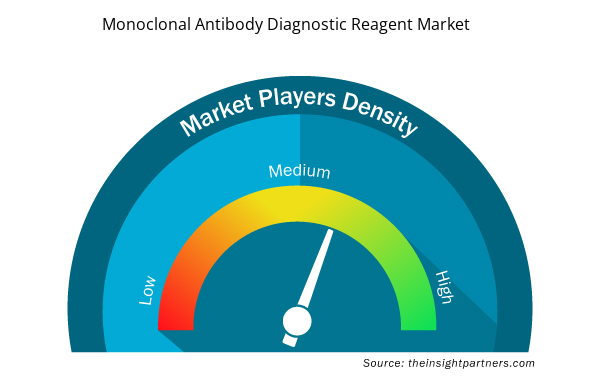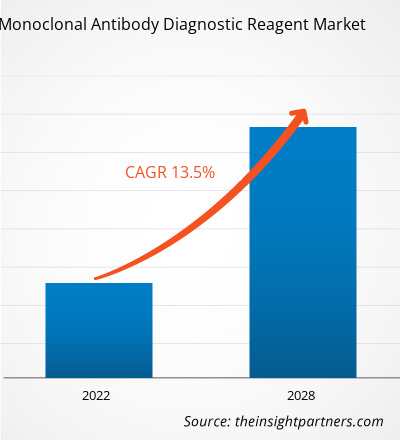2021 年全球单克隆抗体诊断试剂市场价值为 76.5406 亿美元;预计 2022 年至 2028 年的复合年增长率为 13.5%。
单克隆抗体 (mAb) 是重要的诊断试剂,用于生物医学研究、微生物学研究、肝炎、艾滋病、流感、单纯疱疹、衣原体感染的诊断以及感染和癌症的治疗。针对单个表位的单克隆抗体具有高度特异性、均质性,并且可以无限量地生产。杂交瘤衍生或细菌克隆的单克隆抗体技术使得能够大规模生产针对抗原位点(无论是激素、酶、受体还是微生物产品)的高度特异性探针。推动该市场增长的主要因素包括癌症和其他慢性疾病的患病率不断上升、存在大量正在试验的药物以及为开发新疗法而进行的大量研发工作。
报告对全球单克隆抗体诊断试剂市场进行了深入分析,重点介绍了各种参数,包括市场趋势、技术进步、市场动态以及全球主要市场参与者的竞争格局分析。报告还介绍了 COVID-19 疫情对所有地区市场的影响。
COVID-19 疫情对单克隆抗体诊断试剂市场的整体影响是积极的;因此,市场继续获得关注,预计未来几年将会增长。Celltrion Group 宣布,韩国食品药品安全部 (MFDS) 已批准用于治疗 COVID-19 的单克隆抗体 regdanvimab (CT-P59),供 50 岁及以上的老年患者或患有至少一种潜在疾病(如肥胖、心血管疾病、慢性肺病、糖尿病、慢性肾病、慢性肝病以及使用免疫抑制剂的 COVID-19 轻度症状患者)和 COVID-19 中度症状成年患者长期使用。此外,在其他国家已成功用于治疗轻度或中度症状的 COVID-19 患者的单克隆抗体疗法现已获得印度药品管理总局 (DCGI) 批准在印度使用。
定制此报告以满足您的需求
您可以免费定制任何报告,包括本报告的部分内容、国家级分析、Excel 数据包,以及为初创企业和大学提供优惠和折扣
- 获取此报告的关键市场趋势。这个免费样品将包括数据分析,从市场趋势到估计和预测。
基于地理位置的洞察
按地域划分,全球单克隆抗体诊断试剂市场分为北美(美国、加拿大和墨西哥)、欧洲(法国、德国、英国、西班牙、俄罗斯、意大利和欧洲其他地区)、亚太地区(中国、印度、日本、澳大利亚、韩国、哈萨克斯坦和亚太地区其他地区)、中东和非洲(沙特阿拉伯、阿联酋、南非和中东和非洲其他地区)以及南美洲和中美洲(巴西、阿根廷和南美洲和中美洲其他地区)。
市场洞察
大力研发新型疗法
mAb 的众多应用涉及疾病的预防、诊断和治疗。mAb 在诊断中的应用是最先进的,特别是针对尿液和血液等体液进行的测试。此外,mAb 诊断应用包括 ELISA、蛋白质印迹、免疫印迹、流式细胞术、免疫组织化学、放射免疫学测定和电子显微镜等技术。此外,用于诊断应用的 mAb 可以检测针对牲畜病毒和真菌疾病以及寄生虫疾病的抗原和抗体。
此外,由于单克隆抗体具有选择性、高结合亲和力和免疫原性/低毒性,因此是一种具有广泛应用价值的试剂;单克隆抗体最适合临床、环境和元素研究。单克隆抗体的诊断应用还包括医疗设备、体外测试和医学成像
此外,单克隆抗体的用途也得到了扩展,有助于开发新的免疫疗法,有助于了解一系列疾病。例如,癌症治疗受益于单克隆抗体的研究,最有可能是利妥昔单抗的开发,利妥昔单抗被证明是许多癌症的有效治疗方法。此外,许多单克隆抗体现在已被美国食品药品管理局 (FDA) 认可为可用于商业治疗的安全药物。上述这些因素预计将在预测期内促进单克隆抗体诊断试剂市场的增长。
单克隆抗体诊断试剂市场区域洞察
Insight Partners 的分析师已详细解释了预测期内影响单克隆抗体诊断试剂市场的区域趋势和因素。本节还讨论了北美、欧洲、亚太地区、中东和非洲以及南美和中美洲的单克隆抗体诊断试剂市场细分和地理位置。

- 获取单克隆抗体诊断试剂市场的区域特定数据
单克隆抗体诊断试剂市场报告范围
| 报告属性 | 细节 |
|---|---|
| 2021 年市场规模 | 76.5亿美元 |
| 2028 年市场规模 | 185.1亿美元 |
| 全球复合年增长率(2021 - 2028) | 13.5% |
| 史料 | 2019-2020 |
| 预测期 | 2022-2028 |
| 涵盖的领域 | 通过测试
|
| 覆盖地区和国家 | 北美
|
| 市场领导者和主要公司简介 |
|
单克隆抗体诊断试剂市场参与者密度:了解其对业务动态的影响
单克隆抗体诊断试剂市场正在快速增长,这得益于终端用户需求的不断增长,而这些需求又源于消费者偏好的不断变化、技术进步以及对产品优势的认识不断提高等因素。随着需求的增加,企业正在扩大其产品范围,进行创新以满足消费者的需求,并利用新兴趋势,从而进一步推动市场增长。
市场参与者密度是指在特定市场或行业内运营的企业或公司的分布情况。它表明在给定市场空间中,相对于其规模或总市场价值,有多少竞争对手(市场参与者)存在。
在单克隆抗体诊断试剂市场运营的主要公司有:
- 生物基因
- Bio-Rad 实验室有限公司
- Biocare 医疗有限公司
- 赛尔群医疗有限公司
- 创意诊断
免责声明:上面列出的公司没有按照任何特定顺序排列。

- 了解单克隆抗体诊断试剂市场的主要参与者概况
基于测试的见解
根据测试,全球单克隆抗体诊断试剂市场细分为双抗原夹心化学发光法、酶联免疫吸附测定法、重组免疫印迹测定法和斑点免疫金渗滤测定法。2021 年,酶联免疫吸附测定法占据最大市场份额,预计 2022 年至 2028 年的复合年增长率最高。
基于应用的洞察
根据应用,全球单克隆抗体诊断试剂市场细分为激素诊断、肿瘤监测、病毒检测和其他应用。肿瘤监测细分市场在 2021 年占据最大市场份额,预计在预测期内将实现最高复合年增长率。
全球单克隆抗体诊断试剂市场参与者正在采用有机战略,包括产品发布和扩张,以扩大其全球足迹和产品组合并满足不断增长的产品需求。市场上运营的一些主要参与者是 BioGenex;Bio-Rad Laboratories, Inc.;Biocare Medical, LLC;Celltrion Healthcare Co., Ltd.;Creative Diagnostics;GenWay Biotech;Thermo Fisher Scientific Inc.;ABclonal, Inc.;Apto-Gen;和 Abcam plc。
- 历史分析(2 年)、基准年、预测(7 年)及复合年增长率
- PEST 和 SWOT 分析
- 市场规模价值/数量 - 全球、区域、国家
- 行业和竞争格局
- Excel 数据集


- Aesthetic Medical Devices Market
- Nuclear Decommissioning Services Market
- Trade Promotion Management Software Market
- Vision Care Market
- Precast Concrete Market
- Medical Second Opinion Market
- Neurovascular Devices Market
- Truck Refrigeration Market
- Mail Order Pharmacy Market
- Military Rubber Tracks Market

Report Coverage
Revenue forecast, Company Analysis, Industry landscape, Growth factors, and Trends

Segment Covered
This text is related
to segments covered.

Regional Scope
North America, Europe, Asia Pacific, Middle East & Africa, South & Central America

Country Scope
This text is related
to country scope.
常见问题
The enzyme-linked immunosorbent assay segment held the largest share of the market in the global monoclonal antibody diagnostic reagent market contributing a market share of 37.89% in 2021.
The Asia Pacific is expected to be the fastest-growing region in the monoclonal antibody diagnostic reagent market over the forecast period due to growing investments from international players in China and India, increasing disposable income, and chronic diseases in these regions will show promising growth in the monoclonal antibody diagnostic reagent market.
The monoclonal antibody diagnostic reagent market is expected to be valued at US$ 18,507.20 million in 2028.
The CAGR value of the monoclonal antibody diagnostic reagent market during the forecasted period of 2022-2028 is 13.5%
The monoclonal antibody diagnostic reagent market is estimated to be valued at US$ 8,642.00 million in 2022.
The monoclonal antibody diagnostic reagent market majorly consists of the players, such as BioGenex; Bio-Rad Laboratories, Inc.; Biocare Medical, LLC; Celltrion Healthcare Co., Ltd.; Creative Diagnostics; GenWay Biotech; Thermo Fisher Scientific Inc.; ABclonal, Inc.; Apto-Gen; and Abcam plc.
Rising prevalence of cancer and other chronic diseases, extensive R&D efforts to develop novel therapies, and presence of strong pipeline of drugs under trial are the major factors contributing to the growth of the monoclonal antibody diagnostic reagent industry.
Monoclonal antibodies (mAb) are important diagnostic reagents that are being used in biomedical research, microbiological research in diagnosis of Hepatitis, AIDs, influenza, herpes simplex, chlamydia infections and in treatment of infections and cancer. The monoclonal antibodies being directed against single epitopes are highly specific, homogeneous and can be produced in unlimited quantities. The hybridoma-derived or bacterially cloned monoclonal antibody technology has enabled the mass production of highly specific probes for antigenic sites, whether on hormones, enzymes, receptors, or microbial products.
Trends and growth analysis reports related to Life Sciences : READ MORE..
The List of Companies - Monoclonal Antibody Diagnostic Reagent Market
- BioGenex
- Bio-Rad Laboratories, Inc.
- Biocare Medical, LLC
- Celltrion Healthcare Co., Ltd.
- Creative Diagnostics
- GenWay Biotech
- Thermo Fisher Scientific Inc.
- ABclonal, Inc.
- Apto-Gen
- Abcam plc.
The Insight Partners performs research in 4 major stages: Data Collection & Secondary Research, Primary Research, Data Analysis and Data Triangulation & Final Review.
- Data Collection and Secondary Research:
As a market research and consulting firm operating from a decade, we have published and advised several client across the globe. First step for any study will start with an assessment of currently available data and insights from existing reports. Further, historical and current market information is collected from Investor Presentations, Annual Reports, SEC Filings, etc., and other information related to company’s performance and market positioning are gathered from Paid Databases (Factiva, Hoovers, and Reuters) and various other publications available in public domain.
Several associations trade associates, technical forums, institutes, societies and organization are accessed to gain technical as well as market related insights through their publications such as research papers, blogs and press releases related to the studies are referred to get cues about the market. Further, white papers, journals, magazines, and other news articles published in last 3 years are scrutinized and analyzed to understand the current market trends.
- Primary Research:
The primarily interview analysis comprise of data obtained from industry participants interview and answers to survey questions gathered by in-house primary team.
For primary research, interviews are conducted with industry experts/CEOs/Marketing Managers/VPs/Subject Matter Experts from both demand and supply side to get a 360-degree view of the market. The primary team conducts several interviews based on the complexity of the markets to understand the various market trends and dynamics which makes research more credible and precise.
A typical research interview fulfils the following functions:
- Provides first-hand information on the market size, market trends, growth trends, competitive landscape, and outlook
- Validates and strengthens in-house secondary research findings
- Develops the analysis team’s expertise and market understanding
Primary research involves email interactions and telephone interviews for each market, category, segment, and sub-segment across geographies. The participants who typically take part in such a process include, but are not limited to:
- Industry participants: VPs, business development managers, market intelligence managers and national sales managers
- Outside experts: Valuation experts, research analysts and key opinion leaders specializing in the electronics and semiconductor industry.
Below is the breakup of our primary respondents by company, designation, and region:

Once we receive the confirmation from primary research sources or primary respondents, we finalize the base year market estimation and forecast the data as per the macroeconomic and microeconomic factors assessed during data collection.
- Data Analysis:
Once data is validated through both secondary as well as primary respondents, we finalize the market estimations by hypothesis formulation and factor analysis at regional and country level.
- Macro-Economic Factor Analysis:
We analyse macroeconomic indicators such the gross domestic product (GDP), increase in the demand for goods and services across industries, technological advancement, regional economic growth, governmental policies, the influence of COVID-19, PEST analysis, and other aspects. This analysis aids in setting benchmarks for various nations/regions and approximating market splits. Additionally, the general trend of the aforementioned components aid in determining the market's development possibilities.
- Country Level Data:
Various factors that are especially aligned to the country are taken into account to determine the market size for a certain area and country, including the presence of vendors, such as headquarters and offices, the country's GDP, demand patterns, and industry growth. To comprehend the market dynamics for the nation, a number of growth variables, inhibitors, application areas, and current market trends are researched. The aforementioned elements aid in determining the country's overall market's growth potential.
- Company Profile:
The “Table of Contents” is formulated by listing and analyzing more than 25 - 30 companies operating in the market ecosystem across geographies. However, we profile only 10 companies as a standard practice in our syndicate reports. These 10 companies comprise leading, emerging, and regional players. Nonetheless, our analysis is not restricted to the 10 listed companies, we also analyze other companies present in the market to develop a holistic view and understand the prevailing trends. The “Company Profiles” section in the report covers key facts, business description, products & services, financial information, SWOT analysis, and key developments. The financial information presented is extracted from the annual reports and official documents of the publicly listed companies. Upon collecting the information for the sections of respective companies, we verify them via various primary sources and then compile the data in respective company profiles. The company level information helps us in deriving the base number as well as in forecasting the market size.
- Developing Base Number:
Aggregation of sales statistics (2020-2022) and macro-economic factor, and other secondary and primary research insights are utilized to arrive at base number and related market shares for 2022. The data gaps are identified in this step and relevant market data is analyzed, collected from paid primary interviews or databases. On finalizing the base year market size, forecasts are developed on the basis of macro-economic, industry and market growth factors and company level analysis.
- Data Triangulation and Final Review:
The market findings and base year market size calculations are validated from supply as well as demand side. Demand side validations are based on macro-economic factor analysis and benchmarks for respective regions and countries. In case of supply side validations, revenues of major companies are estimated (in case not available) based on industry benchmark, approximate number of employees, product portfolio, and primary interviews revenues are gathered. Further revenue from target product/service segment is assessed to avoid overshooting of market statistics. In case of heavy deviations between supply and demand side values, all thes steps are repeated to achieve synchronization.
We follow an iterative model, wherein we share our research findings with Subject Matter Experts (SME’s) and Key Opinion Leaders (KOLs) until consensus view of the market is not formulated – this model negates any drastic deviation in the opinions of experts. Only validated and universally acceptable research findings are quoted in our reports.
We have important check points that we use to validate our research findings – which we call – data triangulation, where we validate the information, we generate from secondary sources with primary interviews and then we re-validate with our internal data bases and Subject matter experts. This comprehensive model enables us to deliver high quality, reliable data in shortest possible time.


 获取此报告的免费样本
获取此报告的免费样本